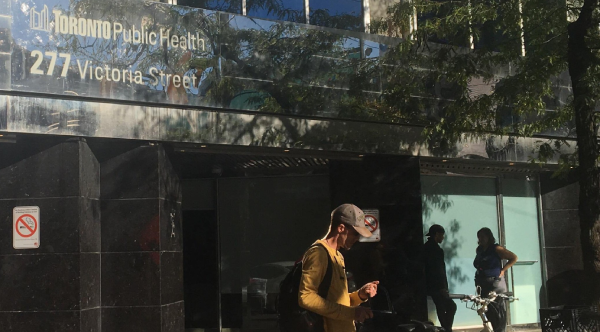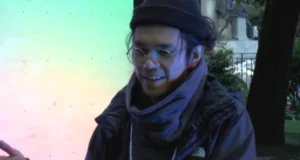
How opioids are affecting campus safety
Brooklyn Morris doesn’t feel safe walking to and from class.
The first-year psychology student says she’s been harassed more than once, including on Victoria Street near the campus store.
Morris, on her way to class one day, took her usual route along Yonge-Dundas Square. She walked along the clear panels on the southeast side of the square just like she always does. But this time, a man tapped on the glass to get her attention.
“What do you want?” she asked.
He gestured and told her to come towards him. She refused.
Morris says that’s when the man called her a “f***ing b**ch.” More than once, people have verbally harassed her while she was walking to and from class.
Ryerson increased security measures this year, but some students — like Morris — say that harm reduction programs on and near campus add to safety concerns.
“I feel like it’s definitely the location of our school. Yonge-Dundas Square is at the heart of the city,” said Morris. “Because of the harm reduction things we have in this area, it definitely brings [around] those people who want to use those services.”
Opioid use
The Chang School found used needles in their assignment drop box and in Lake Devo, according to a report from The Eyeopener. The school is right next to a Toronto Public Health building, which offers addiction treatment resources such as supervised injections and naloxone kits.
The kits are used to temporarily treat opioid overdoses. Opioids can be used to reduce pain and/or to get high. Common opioids include fentanyl, morphine, oxycodone, methadone and heroin, according to Ontario.ca.
A Public Health Ontario report found that there were 303 opioid-related deaths in Toronto in 2017, a 63 per cent increase from 2016. A separate report on the City of Toronto website shows an increase in opioid substitution treatment from 2016 to 2018.
True North Medical Centre, which also offers addiction treatment, has been open in the area since 1999 and recently opened a clinic near campus on Dalhousie Street. In the clinic, supervised patients can use methadone and suboxone as substitutes for opioids.
“Nobody assumes that treating other illnesses poses a public risk but somehow the public and the media do when it comes to this illness,” said Dr. Chris Cavacuiti, the medical director and owner of True North Medical Centre, in an email to RUtv News.
“In fact, the opposite is true. Patients who receive respectful and evidence-based treatment for their substance use issues pose less risk to public safety. Not more risk.”
Cavacuiti began the program after graduating from residency in 1997. The first location was at 61 Queen St. E, a block from the new location on Dalhousie Street.
“For nearly 2 decades, we have been safely and effectively seeing the same variety of patients that we continue to see today,” he wrote.
Victoria Beck, a third-year architecture science student, says she doesn’t like the idea of clinics that offer harm reduction programs being too close to campus.
“You can actually see people using drugs on campus if you’re here late enough,” she explained.
However, Beck thinks these programs still play an important role.
“At least you’re taking [drugs] off of the streets and actually moving people who would have otherwise used drugs on campus,” she said.
Security incidents
At the time of writing, there were 58 reported Ryerson security incidents dating back to July 6 of this year. This is the oldest data currently available. Almost all of the incidents are assaults, but it is unclear how many of them are related to drug use or possession.
Ryerson does not currently have annual reports available online, but that’s in the works, says Denise Campbell, the executive director of community safety and security at Ryerson. No reports of drug possession or use were listed on the security website for the past year at the time of writing.
The site lists criteria for security incidents as “assaults, including sexual assault; robbery; incidents of indecency, mischief and voyeurism; uttering of threats and criminal harassment; notices of violent crimes from Toronto Police Services 51 and 52 division that are reported to have occurred within Ryerson’s boundaries.”
The University of Toronto’s St. George Campus, on the other hand, listed two reported security incidents in 2016 that involved drug use or possession. York University reported 10 in the 2017-18 year.
What’s Ryerson doing?
Ryerson recently approved a sharps disposal project. Disposal containers have been installed across campus in the pilot project, with 510 more to be installed in Ryerson washrooms by the end of June 2019.
“The pilot project has demonstrated that the sharps disposal containers are being actively used,” said Geeta Sharma, Ryerson’s director of environmental health and safety, in an email.
“This has successfully reduced the number of sharps found in trash bins, on washroom floors, on the ground outside campus buildings and flushed down the drain in some washrooms.”
As of this summer, Ryerson has equipped its security staff with naloxone kits. The university also took some additional steps to expand security staff this year to address safety concerns on campus.
Last year, there were about six to eight security guards on patrol during a shift plus a special projects crew who responded to events and more serious incidents. This year Ryerson has a general patrol team of about four to seven officers, plus a “Crew Five” group and two community engagement officers. The community engagement officers are responsible for proactive outreach, including crime prevention activities. The Crew Five team are equipped with naloxone kits and respond to medical calls and areas of need such as protests or event patrols.
Campbell advises students to always be aware of their surroundings and to take advantage of safety resources like WalkSafe and self-defence classes. Students can also report finding syringes to campus security.

